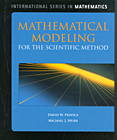- About MAA
- Membership
- MAA Publications
- Periodicals
- Blogs
- MAA Book Series
- MAA Press (an imprint of the AMS)
- MAA Notes
- MAA Reviews
- Mathematical Communication
- Information for Libraries
- Author Resources
- Advertise with MAA
- Meetings
- Competitions
- Programs
- Communities
- MAA Sections
- SIGMAA
- MAA Connect
- Students
- MAA Awards
- Awards Booklets
- Writing Awards
- Teaching Awards
- Service Awards
- Research Awards
- Lecture Awards
- Putnam Competition Individual and Team Winners
- D. E. Shaw Group AMC 8 Awards & Certificates
- Maryam Mirzakhani AMC 10 A Awards & Certificates
- Two Sigma AMC 10 B Awards & Certificates
- Jane Street AMC 12 A Awards & Certificates
- Akamai AMC 12 B Awards & Certificates
- High School Teachers
- News
You are here
Mathematical Modeling for the Scientific Method

Publisher:
Jones and Bartlett Learning
Publication Date:
2011
Number of Pages:
490
Format:
Hardcover
Series:
International Series in Mathematics
Price:
135.95
ISBN:
978076377967
Category:
Textbook
[Reviewed by , on ]
Charles Ashbacher
11/9/2012
This book is nothing like I thought it would be. Rather than a series of exercises of the form:
- Posed problem based on the physical world
- Construction of the mathematical model of the problem
- Solution of the mathematical model
The book is almost exclusively a brief description of the mathematics needed to perform basic modeling.
Chapter 1 is a review of algebra from the basics of set theory up through the introduction of abstract algebraic structures such as groups and rings. Chapter 2 begins with covering relations and functions and concludes with the most commonly used probability functions. Chapter 3 covers the basics of statistics, from descriptive to inferential. Chapter 4 is a survey of linear algebra, chapter 5 covers differential and integral calculus with series and chapter 6 covers vector calculus. All of this is done in 380 pages.
Chapter 7 has the title “Mathematical Modeling” but it is still more theory than practice. Topics include “First Order Differential Equations” and “Systems of Nonlinear Differential Equations” and all of this is done in approximately 40 pages. Chapter 8 has the title “The Scientific Method” and is a strange one. A wide variety of topics are covered, but all very superficially. For example there are the following topics with the number of allocated pages:
- Quarks and Groups, two pages
- A Small Ising Model of Magnetism, two pages
- The Shape of DNA, one page
- Cellular homeostasis, two pages
- Thermodynamics of Oceans and Atmosphere, four pages
- Quantum Cosmology and the Big-Bang Theory, six pages
Exercises are given at the end of each section, further reducing the amount devoted to the topics, but no solutions are provided.
Given that this is a survey of most of the mathematics used in basic modeling, one questions what the assumed background of the reader is. With 380 pages devoted to the first six chapters, there is no real depth of coverage of any single subject. In my opinion; this is not enough for the student being exposed to the topic for the first time.
Charles Ashbacher splits his time between consulting with industry in projects involving math and computers, teaching college classes and co-editing The Journal of Recreational Mathematics. In his spare time, he reads about these things and helps his daughter in her lawn care business.
Part 1 Foundations
Chapter 1 Review of Algebra
Chapter 2 Functions and Relations
Chapter 3 Statistics
Part 2 Multidimensionality
Chapter 4 Linear Algebra and Matrices
Chapter 5 Calculus
Chapter 6 Vector Calculus and Differential Equations
Part 3 Applications
Chapter 7 Mathematical Modeling
Chapter 8 The Scientifc Method
- Log in to post comments




